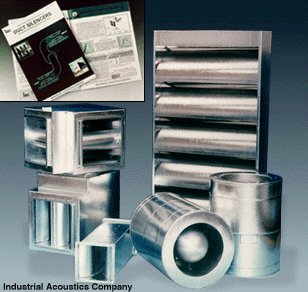|
SOUND REDUCTION / SILENCERS
Sound reduction can become necessary in order to reduce the airborne
noise from or through ducts. In those case round or rectangular
silencers are often used close to noise source. To minimise airborne
noise in enclosed spaces complete or partial sound enclosures
are being used.
Many times a combination is necessary, since unless an enclosure
is combined with inlet and outlet silencers, the sound will travel
through the ducts.
To reduce structure borne noise vibration attenuator may be necessary
 |
The modules are varied by the relationship between the
silencer wall and the channel to achieve a continuos range
of insertion loss values. A complete attenuator consist of
a number of the same modules combined to match the desired
flow rate and duct size.
Sound Enclosures
The sound reduction properties of a sound enclosures is
mainly determined by it's design and assembly. A major factor
is the material selection and the relative size of the air
gaps between the panels.
To cover most applications we have three different sound
enclosure types:
Sound insulation
The fan casing is clad with sound absorbing material. In
most cases inlet/outlet silencers or heavy gadge ducting
is required to achieve the desired effect.
Sound enclosure type A
Self supporting sound panels are combined with 2 snaplocks???and
can be assembled/disassembled at site. A multitude of designs
are available such as sound enclosure with free inlet, ducted
at inlet/outlet and or forced ventilation.
Sound enclosure type B
As is the case with type B many different designs can be
accommodated. The main difference is a supporting frame
to provide additional rigidity and heavier gadge material.
This type is more suitable for larger installations or installation
outside and with type A higher noise insulation is achieved
than.
In addition for special applications we offer enclosures
with higher insertion losses, for example double walled
enclosures. |
| |
|
| Selection of Silencers |
|
| |
|
|

